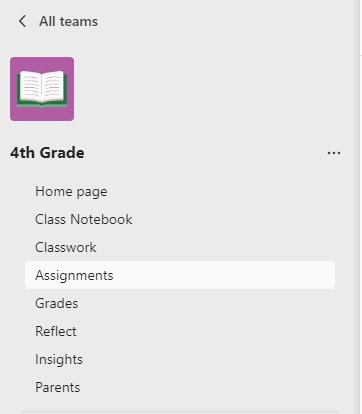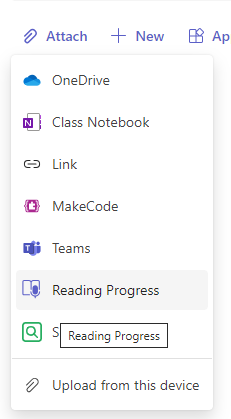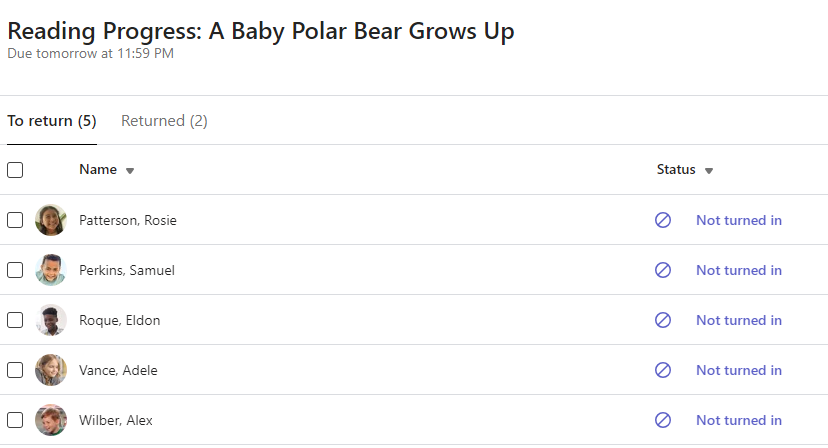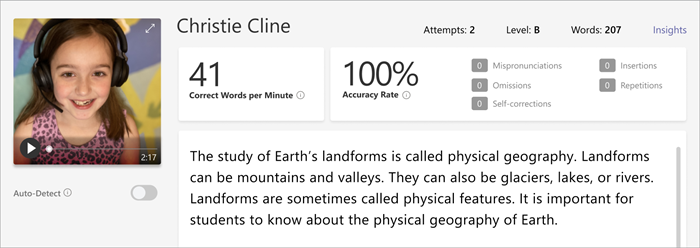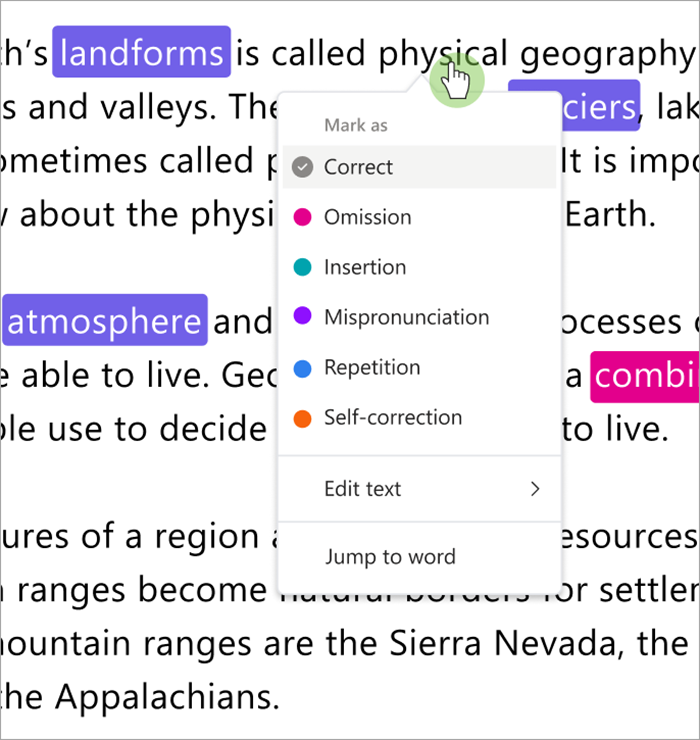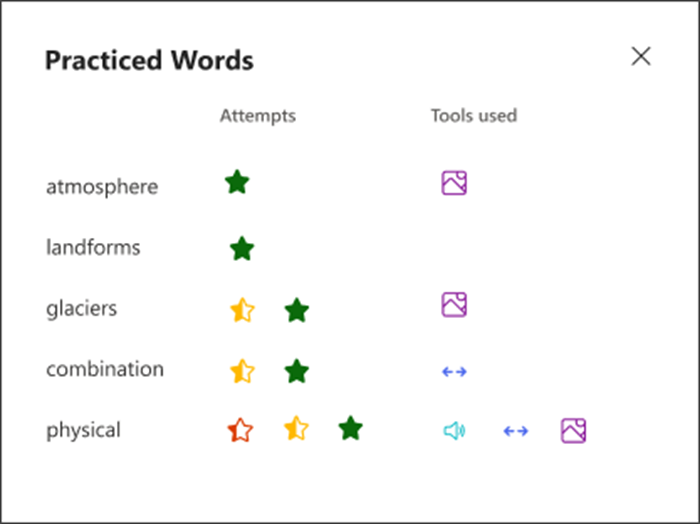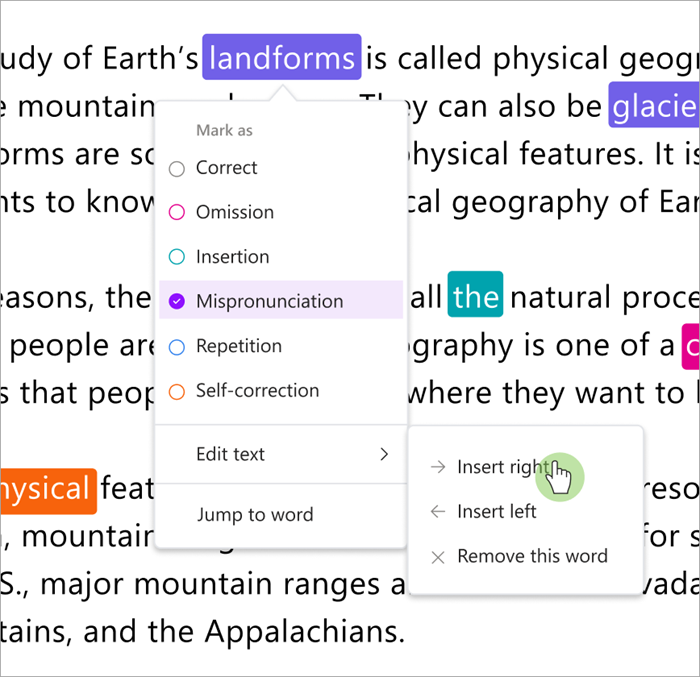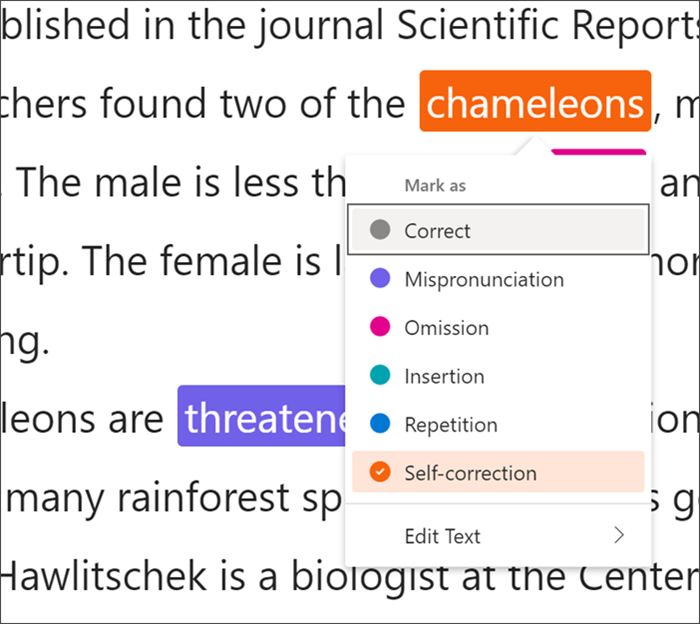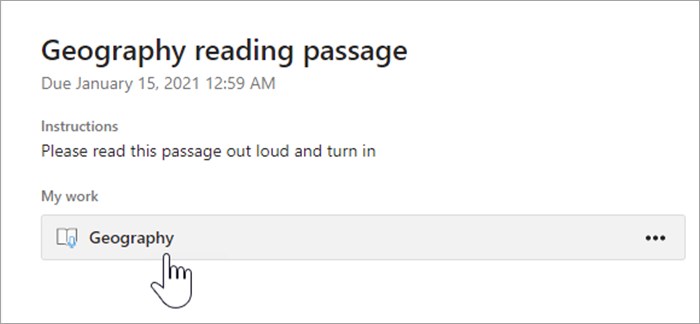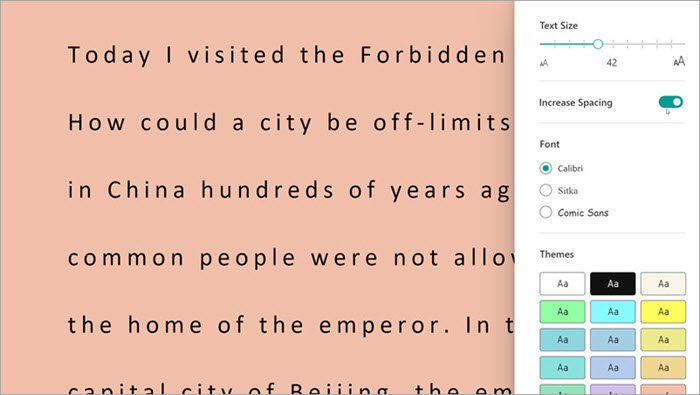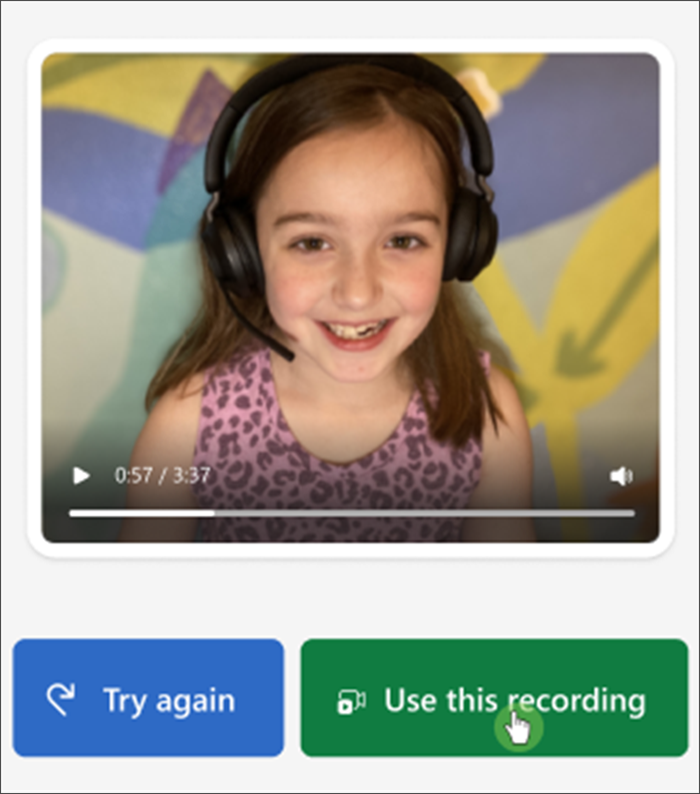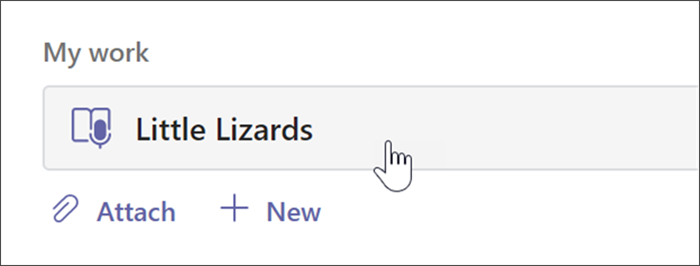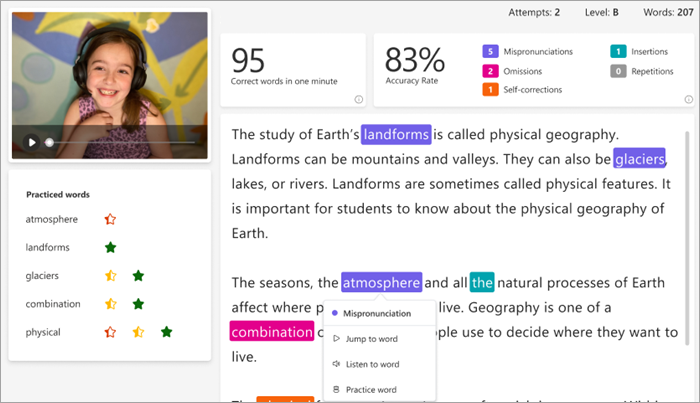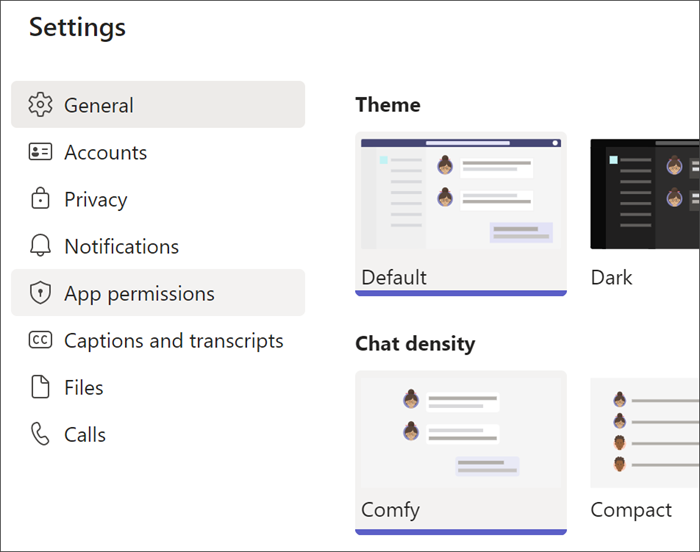Reading Progress is a free tool built into Microsoft Teams designed to support and track reading fluency in your class. Students record their reading on camera and submit it to you. As you mark and return their work, data is automatically collected and organized in Insights, helping you spend more time with students and less time analyzing data.
Create a Reading Progress assignment
Support independent reading practice with Reading Progress assignments in Teams.
-
Navigate to the desired class, then select Assignments.
-
Select Create>Assignment.
-
Enter a title for this assignment – this is required.
-
Select Attach. Then select Reading Progress from the dropdown menu.
-
To select a passage for your students:
-
Choose Upload Word or PDF to use your own files, including files from Class Notebook, your Teams files, or OneDrive.
-
Select Browse sample library to use passages provided by ReadWorks.
6. (Optional) Complete the additional fields to create more data sorting opportunities when reviewing student work.
-
Reading level: Identify reading levels in the way that works best for your class. Any reading level you enter will be searchable in Insights.
-
Genre: Select Fiction or Non-fiction.
-
Number of Attempts: Choose Unlimited to allow students plenty of opportunities to practice, or select any number to limit attempts.
-
Pronunciation sensitivity: Specify how strict you'd like Auto-detect to be when listening and estimating errors. Choose Less sensitive to leave more flexibility for pronunciation, and More sensitive to demand more exact reading performance. This setting is adjustable when reviewing student work.
Note: Pronunciation detection for each language is generalized based on common pronunciation and may not recognize accents and dialects well. This is just a starting point, and we are working to ensure those with accents and dialects are included. Use your discretion to mark errors manually when the speech detection does not meet the needs of your student.
-
Comprehension: defaults to Off when you create a Reading Progress assignment. Toggle Comprehension to On from here if desired.
-
Require video: Select No to give students the choice to submit audio only.
-
Reading Coach defaults to On when you create a Reading Progress assignment. Toggle Reading Coach to Off from here if desired.
-
Edit your passage: If you've uploaded a Word or PDF document of your own, you can edit the passage right in Reading Progress. Select Edit, then make any changes you'd like in the document.
-
Select Edit language to adjust the language Auto-detect will listen for.
-
Select the checkmark when you're done editing.
-
Note: ReadWorks passages are not editable. Passage details like title, reading level and genre will populate automatically.
-
Student View: Select student view to trial the student experience.
7. Select Next.
8. (Optional) Edit additional aspects of your assignment by adding Instructions, changing the Points or extending the Date due.
9. Select which student's you'd like to have complete this assignment, then select Assign.
Your students will be notified of their new assignment, and it will appear in your assignments list.
Review and Return student work in Reading Progress
Collect valuable data while you review and return student Reading Progress assignments.
-
Navigate to the desired class, then select the Assignments tab at the top of the page.
-
Under Upcoming select the assignment you're ready to review.
-
Assignments are sorted by To return and Returned.
-
In Returned, select a student who has turned in their assignment. Their recording and the text they were assigned will open in your grading panel.
-
Press Play on your student's recording to hear them read the passage.
-
Mark and categorize student errors by selecting any word they misread. Use the dropdown menu to mark words as correct or categorize an error. Reading Progress will collect and tabulate the errors in the Accuracy rate and Correct words per minute cards at the top of the review panel. Error types include: - Omission: a word in the passage that the student skipped. - Insertion: a word not written in the passage that a student added. - Mispronunciation: a word that wasn't pronounced clearly or correctly. - Repetition: a word that a student reads more than once. - Self-correction: when a student reads incorrectly, recognizes their mistake, and reads again correctly.
-
If the student has added additional words, you can insert them in the body of text.
-
Select the word closest to where you would like to insert text.
-
Choose Edit text from the dropdown menu.
-
Select where you would like to insert text, then type in what you heard the student say.
-
-
To view the words the student practiced with Reading Coach, select Practiced words.
-
Attempts shows how many times the student practiced, with stars to indicate how well they performed.
-
Tools used indicates where students used tools to help them practice and which tools they used.
9. Decide what you would like students to see in their report.
-
Select Edit next to Return full report to student.
-
Choose Full report to include the student's Correct words per minute and Accuracy rate, as well as their marked errors, or Simplified report to return just the color-coded mistakes.
-
Select Custom report to select for yourself exactly which datapoints you'd like your students to see then select Save.
-
Decide if you'd like this change to apply to future assignments or select Just this once.
-
Select Save.
10. Enter written feedback and points for the assignment, then select Return.
11. Press the arrows next to your student's name to quickly navigate to the next student.
Note: You can also select Return for Revision to ask students to try the assignment again.
Use Auto-detect to save time
Estimate student errors to save time. Auto-detect evaluates student recordings to identify likely mispronunciations and other reading errors for educators. Educators can always adjust the errors to reflect student performance.
-
Toggle Auto-detect to On. Estimated errors will appear already marked and categorized on the passage and in the overview cards.
-
Press Play on the student's recording to hear them read the passage.
-
Select any word you want to adjust. You can recategorize errors, mark additional mistakes, or choose Mark as correct as needed. The collected data will retabulate as you make adjustments.
-
To go directly to any word, select it in the passage and choose Jump to word from the drop-down menu.
-
If Auto-detect isn't interpreting your student well, try adjusting Pronunciation sensitivity to change how carefully Auto-detect is when listening and estimating errors.
Keyboard shortcuts for quick reviewing
Once you've selected any word in the text, you can use keyboard shortcuts to navigate the reading and categorize errors.
1. Move from word to word with the Left and Right arrow keys.
2. Use Ctrl+> to jump to the next error word. The video will begin playing again from that point.
3. Use the Space bar to play and pause the video as needed.
4. When you encounter a word you'd like to adjust, press Down or Enter to open the error menu.
-
Continue pressing Down until your desired error type is outlined with a black box.
3. Select Enter to mark the error; the dashboard will recalculate as you mark errors and the dropdown will close.
-
To close the dropdown without marking an error, select the Up arrow key.
Learn More
Pair Reading Progress assignments with Reading Coach
View Reading Progress data in Insights
Complete a Reading Progress assignment
Got a Reading Progress assignment due? To complete this assignment you will record yourself reading out loud. It looks just like your other assignments and will show up in your class team's General channel and in the Assignments tab.
-
Select View Assignment.
-
Select the document under My work to open Reading Progress.
Note: The first time you complete a Reading Progress assignment, you will need to select Allow so the app can access your camera and audio recordings.
-
Ready to read out loud? Press Start to begin.
-
You can select the Immersive Reader
-
When you finish reading, select I'm done.
-
If you'd like, you can review the recording you made. Press Play to review your recording.
-
If your educator allowed more than one try, you can choose Try again to create a new recording.
-
Select Use this recording to attach your recording to the assignment.
-
Don't forget to select Turn in to submit the assignment to your educator.
Celebrate - your brain is getting stronger!
Review your Reading Progress results
When your educator returns your assignment, your mistakes will be color-coded on the text. You can review your video and hear the mistakes you made to help continue growing your reading skills!
1. Tap on the notification you receive when your educator returns your work, or go to Assignments>Completed to find your desired passage.
2. Select the Reading Progress passage labeled My work.
-
Now you can review your mistakes. Select any highlighted word then press Jump to word to see and hear how you read it.
-
Select Listen to this word to hear how it is supposed to be pronounced.
3. Talk to your educator about what your results mean and how you can practice to improve your reading!
Languages that can use the auto-detect feature
Auto-detect is a PREVIEW feature in Reading Progress that estimates errors based on common pronunciation. Documents in any language can be uploaded and marked manually. Languages that are currently supported by Auto-detect include:
-
Afrikaans
-
Amharic
-
Arabic:
-
Algeria
-
Bahrain
-
Egypt
-
Iraq
-
Israel
-
Jordan
-
Kuwait
-
Lebanon
-
Libya
-
Morocco
-
Palestine
-
Qatar
-
Syria
-
Saudi Arabia
-
Tunisia
-
United Arab Emirates
-
Yemen
-
-
Bulgarian
-
Burmese
-
Catalan, Spain
-
Chinese:
-
Hong Kong
-
Taiwan
-
-
Croatian
-
Czech
-
Danish
-
Dutch:
Netherlands
Belgium
-
English:
-
Australia
-
Canada
-
Ghana
-
Great Britain
-
Hong Kong
-
India
-
Kenya
-
New Zealand
-
Nigeria
-
Philippines
-
Singapore
-
Tanzania
-
South Africa
-
United States
-
-
Estonian
-
Farsi
-
Filipino
-
French:
-
Belgium
Canada
-
France
-
Switzerland
-
-
German:
-
Germany
Austria
-
-
Greek
-
Hebrew
-
Hindi
-
Hungarian
-
Icelandic
-
Indonesian
-
Irish
-
Italian
-
Japanese
-
Javanese
-
Kannada
-
Khmer
-
Korean
-
Lao
-
Latvian
-
Lithuanian
-
Macedonian
-
Malay
-
Maltese
-
Marathi
-
Norwegian
-
Polish, Poland
-
Portuguese:
-
Brazil
-
Portugal
-
-
Romanian
-
Russian
-
Serbian
-
Sinhala
-
Spanish:
-
Argentina
-
Bolivia
-
Chile
-
Columbia
-
Costa Rica
-
Cuba
-
Dominican Republic
-
Ecuador
-
Equatorial Guinea
-
Guatemala
-
Honduras
-
Mexico
-
Panama
-
Peru
-
Puerto Rico
-
Paraguay
-
El Salvador
-
Spain
-
United States
-
Uruguay
-
Venezuela
-
-
Slovakian
-
Slovenian
-
Swahili
-
Swedish
-
Tamil
-
Telugu
-
Thai
-
Turkish
-
Ukrainian
-
Uzbek
-
Vietnamese
-
Zulu
We are working to include more languages and dialects. Use your discretion to mark errors manually when the speech detection does not meet the needs of your student.
Running into a problem?
Try these solutions to get Reading Progress up and running. We're always seeking your feedback - so please let us know if the answer to your question isn't here yet.
Microphone and camera access
Some students have reported challenges getting Reading Progress to recognize their camera and/or microphone. This may be because they've accidentally turned off permissions. To fix this:
On mobile, select the icon with student initials.
On desktop, select the ... at the top of the page.
From there:
1. Select Settings, then App permissions.
2. Select Assignments.
3. Make sure the media is toggled on, it should be purple. On mobile, be sure to toggle on both Camera and Microphone. On desktop, they will both be included when you toggle on Media.
Your student may see a prompt about allowing camera and audio the next time they open a Reading Progress assignment. They will need to Allow permissions to start their assignment.
Tips:
-
If this doesn't work, check to see if another app is using your camera.
-
Some mobile devices may not be up-to-date enough to support video. Students on unsupported mobile devices can toggle the video camera to off and record with audio only.
-
On some iOS devices, App permissions may not be available. In this case, try:
-
Go to your device Settings
-
Scroll to find the Teams app
-
Turn on Microphone and Camera toggles

